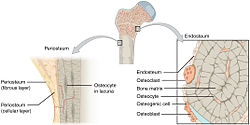Pericranium
| Periosteum | |
|---|---|

The periosteum covers the outside of bones.
|
|

|
|
| Details | |
| Identifiers | |
| Latin | Periosteum |
| Code | TH H2.00.03.7.00018 |
| Dorlands /Elsevier |
p_13/12628368 |
| TA | A02.0.00.007 |
| TH | H2.00.03.7.00018 |
| FMA | 24041 |
|
Anatomical terminology
[]
|
|
The periosteum is a membrane that covers the outer surface of all bones, except at the joints of long bones.Endosteum lines the inner surface of all bones.
The periosteum consists of dense irregular connective tissue. It is divided into an outer "fibrous layer" and inner "cambium layer" (or "osteogenic layer"). The fibrous layer contains fibroblasts, while the cambium layer contains progenitor cells that develop into osteoblasts. These osteoblasts are responsible for increasing the width of a long bone and the overall size of the other bone types. After a bone fracture the progenitor cells develop into osteoblasts and chondroblasts, which are essential to the healing process.
As opposed to osseous tissue, the periosteum has nociceptive nerve endings, making it very sensitive to manipulation. It also provides nourishment by providing the blood supply to the body from the marrow. The periosteum is attached to the bone by strong collagenous fibers called Sharpey's fibres, which extend to the outer circumferential and interstitial lamellae. It also provides an attachment for muscles and tendons.
The periosteum that covers the outer surface of the bones of the skull is known as the "pericranium", except when in reference to the layers of the scalp.
The word Periosteum is derived from the Greek Peri-, meaning "surrounding", and -osteon, meaning "bone". The Peri refers to the fact that the Periosteum is the outermost layer of long bones, surrounding other inner layers.
Diagrammatic section of head.
...
Wikipedia
